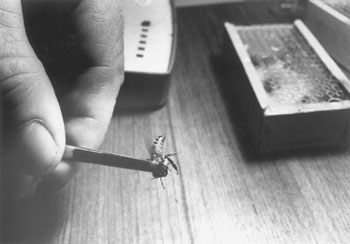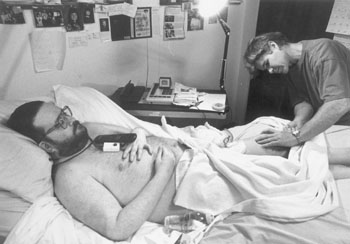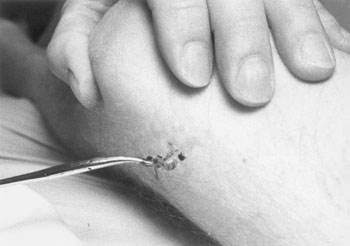Just Beeing There
Busy Bee: Bee-venom therapist Ted Clausen holds one of his little helpers before an adrenaline-pumping bite.
A good stinging provided by therapist Ted Clausen might be the answer to questions of pain faced daily by multiple sclerosis patients
By Sarah Phelan
THE MINUTE I LAID EYES ON TED Clausen, I knew he was a practical soul. Something about the way he was striding through the park in hiking boots and a weathered Panama hat told me he was the tweezers-carrying type. Which was good news to me, given that I was nursing a fistful of splinters incurred in a rollerblading accident moments earlier. I was right about the tweezers, but at nine inches long, they took me by surprise.
Noticing my raised eyebrows, Clausen explained that when he's not removing splinters, he uses his oversized tool to catch bees in his job as a home health care worker. Turns out he gives one of his patients stinging sessions. And we're not talking one little sting here or there, but 20 stings per session, three sessions per week, which totals 3,120 stings each year. Ouch!
Next thing I knew, I was making a date to see Clausen and the bees do their sting thing, even though this made me nervous, since bees are armed and extremely dangerous, at least if you're allergic to their stings.
Now, I'd found out about the armed part very early in life, when a honeybee stung me while I was sitting on my potty. As for the extremely dangerous part, that didn't register until years later, when my otherwise dignified aunt freaked out at a sedate garden party because a honeybee was giving her the buzz. From the way she cut a series of brilliantly disruptive zig-zags across an emerald-green lawn, you'd think she was being chased by a killer bee. And, in a way, she was, because one sting could have triggered anaphylactic shock in her, leading to a deadly serious situation with possibly fatal results.
Clausen is deadly serious about bee venom, too, but in a positive sense. He's talking about bee- venom therapy, which is part of the ancient science of using honey- bees and their products for therapeutic purposes. And he's not alone. Hippocrates was into it, as were the Chinese, and it's mentioned in both the Bible and the Koran. But despite these seemingly impeccable credentials, and the fact that it's non-invasive and highly affordable, this new, yet very old, form of natural healing isn't an approved medical procedure. As Clausen puts it, "This is quackery, as far as the medical profession is concerned. But I'm glad to do it, because David wants it and needs it. He believes the stings boost his immune system and help him retain the strength in his right arm and hand."
Do Bee Brothers: David Lucas, a multiple sclerosis patient who has received tri-weekly bee-sting therapy for the past four years, gets a treatment from relief worker Ted Clausen.
And Zen There Are the Bees
CLAUSEN IS REFERRING to his homecare patient, David Lucas. Unlike my aunt, Lucas isn't allergic to bees, but as he lies stark naked on the bed like a milky-white glow-in-the-dark beacon, he has plenty of perfectly good reasons to panic--60 of them, in fact, if you count the bees who are buzzing ominously in a wooden box nearby.
But instead of chickening out, he's looking happy just being here. The reason for his Zen-like composure is twofold--he's motionless, because he's crippled by chronic progressive multiple sclerosis, and he's relaxed, because he's hopeful that the stings will help him battle this incurable autoimmune disease.
To fully comprehend Lucas' plight, you need to know what MS does. As Lucas explains, "Basically, the immune system turns upon the body and trashes the protective sheath that serves as insulation around the spinal cord. It screws it up to the point that the brain thinks, 'Foot! move!' but the message gets lost en route."
That same short-circuiting process can lead to any number of exacerbations, including numbness, spasticity, incontinence, blindness and loss of hearing. And since MS can debilitate you to the point of being unable to breathe or swallow, it's like having an unpredictable death sentence hanging over you at all times.
Nobody wants to die like that, least of all Lucas, which is why he won't give up the fight no matter what. Besides, he's used to adversity: When he was only 18 months old, polio wiped out his left arm and right leg the very last year before Salk's vaccine was developed. But he never let himself be defined by it. As he explains, "Schoolteachers never wanted me in their class: I was always a mad-dog-in-a-meat-locker type, because it made me feel better if I mentally swaggered through a classroom, and proved that I still have a mind and a mouth--that I'm still a mobile unit."
Lucas was working as an escrow officer when he was diagnosed, with MS in the summer of 1988, but his situation quickly deteriorated, and he's been bedridden since 1992. For the past 3 1/2 years, his view of the outside world has been limited to a rectangle of blue, gray or gold skylight above his head, plus whatever the TV or radio has to offer. Friends call or visit him daily, but he's still home alone when it comes to confronting the reality of MS, which has stripped him of almost all strength.
But despite these grisly facts, Lucas hasn't lost his mind, or his sense of humor. "You have a luscious accent," he jokes flirtatiously, referring to my distinctive British twang. "I'd be happy for you to read even the telephone directory to me, anytime." I laugh, then choke up for a moment, as the full force of Lucas' disenfranchisement from the adult world crashes over me. Trapped in his numb, motionless body, Lucas can't hug or hold the ones he loves, let alone walk across the room to kiss them good-bye. Unless a miracle happens.
This far-fetched hope explains how Lucas got into bee-venom therapy, though he admits that when he first heard of BVT, he thought, "Well, that's about as likely to work as painting my head red and waving at passing traffic." But the corteroids he was taking first resulted in clinical euphoria and then stopped working for him, and nothing seemed to be able to fight the drain on his strength. He felt he was losing his grip, until he read about Pat Wagner, a spunky woman from rural Maryland who's known in MS circles as the Queen Bee. Her uncrushable conviction in BVT is inspired by her own miraculous recovery from MS, which put her back on her feet and turned her into BVT's leading light.
In Wagner's opinion, "When people are hospitalized, they don't see any improvement because prescribed medications such as ACTH, steroids and antibiotics merely give the adrenal system [your internal get-well system] a day off for bad behavior. Bee stings, on the other hand, tell your adrenal glands to wake up and work overtime to help get a person better."
So Lucas decided to try BVT in the hope of a miraculous cure. Unfortunately, that hasn't happened for him, but he firmly believes that it helps him maintain what strength is left in his right arm and hand. As he puts it: "Bee venom promotes the body to produce its own version of cortisone. You see and feel the benefits, but they vary from person to person, and BVT may not work for everybody."
The Sting: The bees are persuaded to sting at certain points, based on ancient Chinese acupuncture spots.
Risky Business
RIGHT NOW, CLAUSEN IS locating specific acupuncture points on Lucas' upper body and marking them with a black pen, because Clausen believes that "the two treatments go hand in hand--bee stings on specific acupuncture points work the best." The soothing music of Charles Lloyd's Big Sur Tapestry is playing on the tape deck, and Clausen is looking pretty relaxed. He's been doing BVT for Lucas for almost a year, but he still grimaces when he remembers the first time.
"I was afraid of the bees, and when I opened the wooden box, five or six got loose and were flying around," Clausen says. "The situation felt entirely out of control, and I was afraid I'd run out of bees." What took him a couple of hours then lasts only one hour now, although today the process is a little slower because he's showing Sharon, a potential relief worker, how to clamp a bee's head and thorax between the hemostats. She struggles nervously to secure one of the bumbling insects, while admitting to me that she's afraid of squashing it.
Does Clausen ever feel sorry for the bees? "No, I don't," he answers, "though at home, I do go to a great deal of trouble to usher flies, wasps and bees out the screen door without harming them." Maybe killing them here doesn't bother him because they seem to be Lucas' only hope.
Once Clausen captures a bee, he manipulates it into stinging by gently massaging its back, which induces the bee to think it's attacking and so release its histamine. And when he removes the dying bee, Clausen deliberately leaves in the stinger, because it'll keep pumping venom into Lucas's body for another 10 minutes.
Lucas puts on a brave face throughout, joking that he's showing off, "now that I've got an audience!" But even as he beams, "I can take it!" his limbs give the telltale jerks of MS-induced spasticity, and he admits that he still gets an intense feeling for 30 seconds, followed by an ache for two to three minutes, every time he's stung.
Over on the East Coast, veteran beekeeper Charlie Mraz has been crusading for BVT ever since he tried it 60 years ago in a last-ditch effort to relieve arthritic pain in his knees. Back then, of course, he didn't pay attention to such nonsense as bee stings "until I got rheumatic fever and ended up with painful knees. I suffered for six months. And then, sick and tired of hobbling around, I stung myself on each knee. The next morning I woke up, and something was wrong with my knees. Very wrong. It took me half an hour to admit that overnight I had no more pain," the 91-year-old laughs dryly.
Over the years, Mraz discovered that autoimmune diseases such as multiple sclerosis, arthritis, lupus and scleroderma all respond miraculously to BVT "because when the bee venom goes into the skin, it brings blood into the area, which is the body's way of promoting healing in the place where it got stung, and the immune system immediately responds."
"However," he admits, "there's a different response in different people. For some it's effective. For others there's little response. But despite all the anecdotal evidence about BVT, the medical establishment hasn't spent any time investigating it."
Why? In Mraz's cynical eyes the answer is it's simply not good beeswax: "Because there's no money in it. With bees available in any flower garden, drug companies can't sell synthetic bee venom for $50 a shot." Add to that economic reality the fact that sufferers of MS and other autoimmune diseases are often isolated, immobile and incapable of arguing their case, and you can see why BVT isn't being taken too seriously.
As Lucas sums it up, "if I had the distinctive 'fat tongue' that often accompanies MS, then people would think I was a madman endorsing bee stings." Luckily that isn't so. Articulate and outspoken, he's the perfect crusader for MS and BVT. A call to him at 457-9142 just might answer any questions buzzing around your mind.
This page was designed and created by the Boulevards team.

Robert Scheer
Robert Scheer
Robert Scheer
From the November 21-27, 1996 issue of Metro Santa Cruz
Copyright © 1996 Metro Publishing, Inc.
![[MetroActive News&Issues]](/gifs/news468.gif)